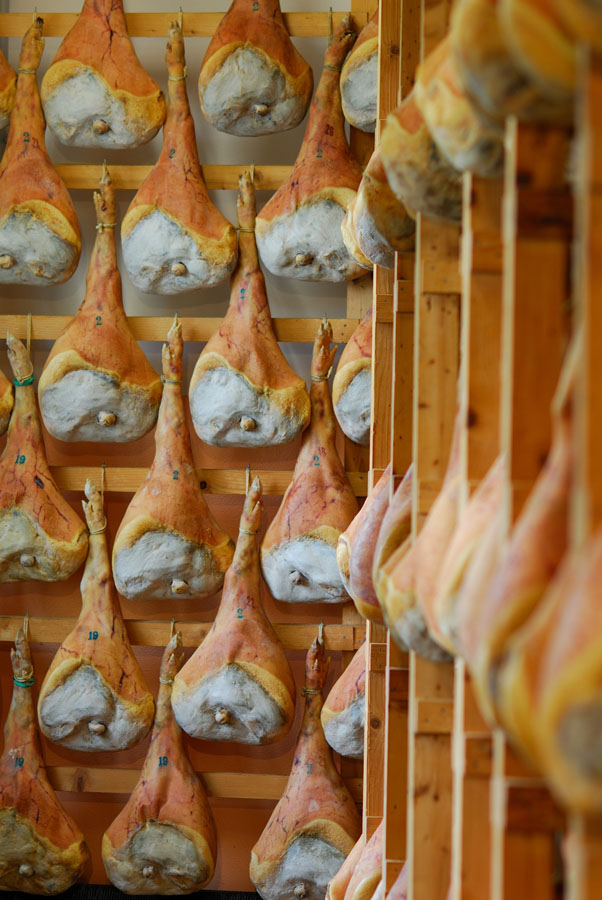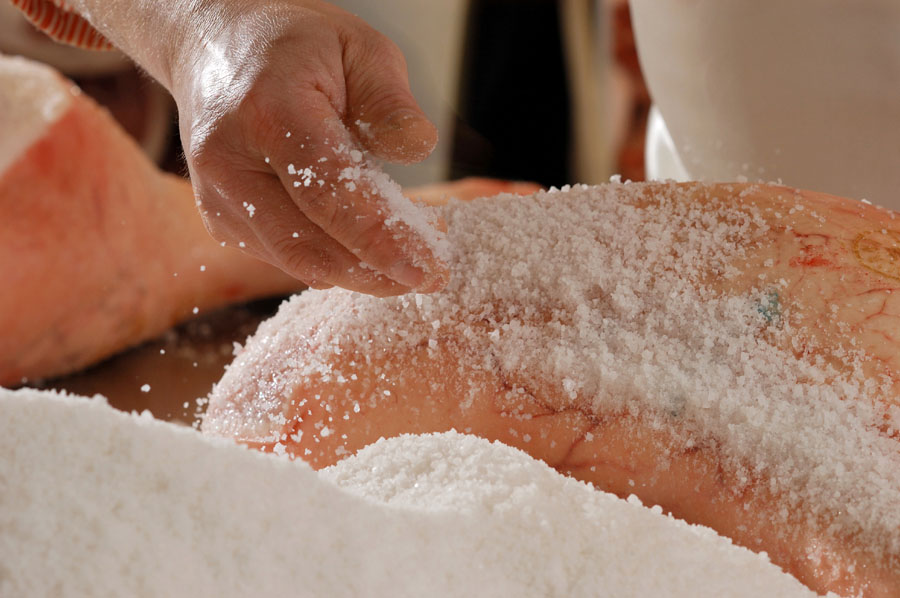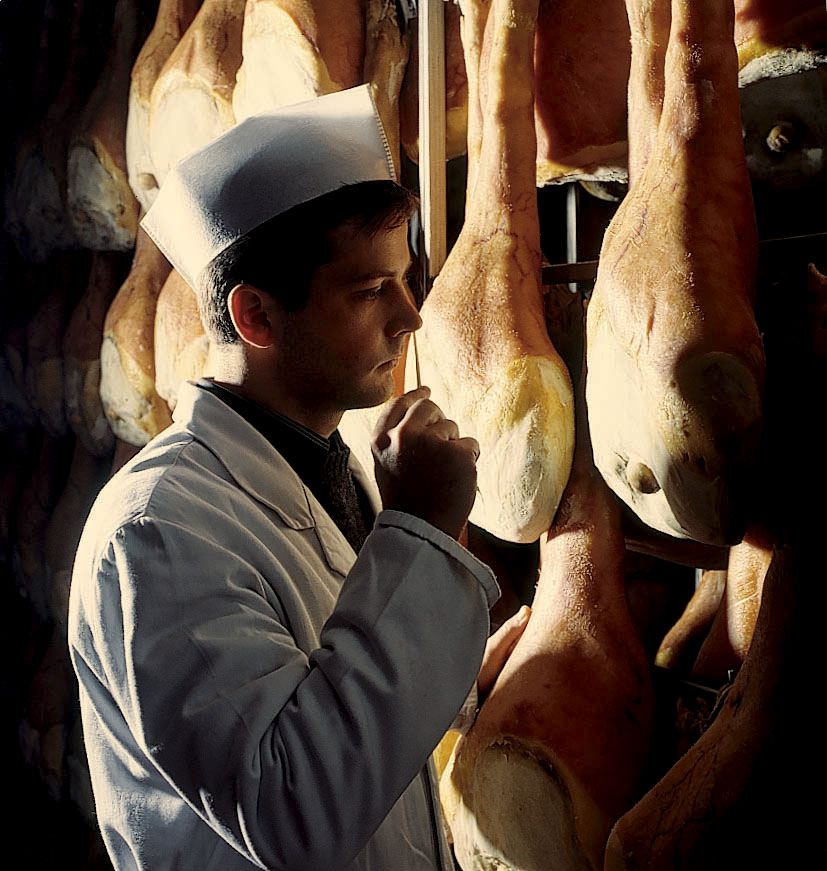 An anthropological and economic "map" can be drawn for air-cured ham. In tracing this map, it will be discovered that ham is a factor of cultural, historical and economic unity right across Europe. Ham is made in the Iberian peninsula, in Italy, in France and in all the countries of central and western Europe. The historical roots of ham production can usually be traced to the growth of rural cultures located in the areas near Europe's great mountain ranges. Air-cured ham - like pig breeding itself and other related economic activities - is one of the most genuinely European food products.
An anthropological and economic "map" can be drawn for air-cured ham. In tracing this map, it will be discovered that ham is a factor of cultural, historical and economic unity right across Europe. Ham is made in the Iberian peninsula, in Italy, in France and in all the countries of central and western Europe. The historical roots of ham production can usually be traced to the growth of rural cultures located in the areas near Europe's great mountain ranges. Air-cured ham - like pig breeding itself and other related economic activities - is one of the most genuinely European food products.
In Italy, more or less renowned varieties of ham are to be found all round the country and above all in the lowlands flanking the river Po. ‘Padania’, the macro-region lying between the Alps and the Apennines, is the true home of this economic phenomenon which brings together local fodder production, animal husbandry and manufacture, linking them inextricably to pig farming and pig-related food products. That is why we find mature air-cured hams in Piedmont, in Emilia at Parma and Modena, in the Berico-Euganean part of the Veneto region and at San Daniele (as well as in the Marche, Umbria and Tuscany).
The hill of San Daniele is of glacial origin. It is located at a short distance from the first Prealpine slopes and overlooks the river Tagliamento. Cold winds blow down on San Daniele from the north. Warm breezes arrive from the Adriatic Sea, only 35 km away as the crow flies and also visible from the hill in good weather. Warm and cool air are mixed together as they travel along the course of the river, which acts as a conduit and natural "air conditioner".
The gravel soil which, being morainal, has excellent drainage properties and the gentle, but constant ventilation are the ideal, ‘textbook’, conditions for air-curing. The Celts were well aware of this. It was the Celts who first made use of salt to conserve pork, which they consumed in large quantities and there is ample evidence of their presence in Friuli in pre-Roman times.
The route to quality
 The pigs used for the preparation of San Daniele air-cured ham come from ten Italian regions, where they are born, bred and slaughtered: Friuli-Venezia Giulia; Veneto; Lombardy; Emilia Romagna; Piedmont; Tuscany; Umbria; Marche; Lazio; Abruzzo. Pigs must belong to traditional genotypes (Large White and Landrace breeds) and may be cross-bred with the Duroc breed or hybridized in other functions which must nevertheless comply with the requisites laid down in the National Pedigree Register for "Italian heavy pigs".
The pigs used for the preparation of San Daniele air-cured ham come from ten Italian regions, where they are born, bred and slaughtered: Friuli-Venezia Giulia; Veneto; Lombardy; Emilia Romagna; Piedmont; Tuscany; Umbria; Marche; Lazio; Abruzzo. Pigs must belong to traditional genotypes (Large White and Landrace breeds) and may be cross-bred with the Duroc breed or hybridized in other functions which must nevertheless comply with the requisites laid down in the National Pedigree Register for "Italian heavy pigs".
To ensure that the "production regulations" are observed, breeders must:
brand piglets immediately after birth with a tattoo on both hind thighs identifying the breeder and the month of the animal's birth; certify the adult pig before slaughter (by adding another identification mark if the animal was fattened at a different stock breeder's from where it was born).
The above measures came into effect in August 1994. The first pigs slaughtered under the new procedure became available in May 1995 and the first hams with their own individual "identity card" were put on the market by the ham makers in June and July 1996.
Fresh pig thighs arrive at the ham maker's with all the relevant documents stamped by the breeder and by the abattoir. A series of checks is carried out at the ham maker's premises to ensure that the pig thighs are suitable for ham making. And so begins the process of making San Daniele prosciutto, from salting through eight other separate stages to the end of maturing (which takes at least 13 months, depending on the size of the ham).
After the ham-making process has been completed, the hams are assessed for quality. In addition to the traditional methods of inspection (needle-probe for aroma, "beating" for texture and a critical expert eye for an overall assessment), since 1993 analytical inspection parameters have been in force. An analytical profile of the ham (batch by batch and month by month) is drawn up for ratios of water, salt and proteins in a grid of minimum and maximum that constitute the optimum levels required to achieve a technologically perfect result with the required organoleptic properties.
 Having passed the inspection checks, San Daniele prosciutto is "branded". A special mark is branded onto the ham. Together with the ham maker's identification code, this mark attests the ham's compliance with DOT/DOP-label product specifications.
Having passed the inspection checks, San Daniele prosciutto is "branded". A special mark is branded onto the ham. Together with the ham maker's identification code, this mark attests the ham's compliance with DOT/DOP-label product specifications.
Since recent developments in consumer demand require that the product should be presented in a wider range of formats, the new law permits San Daniele prosciutto to be sold ready-sliced in special modified-atmosphere packs. For pre-packed ham, the distinctive San Daniele "brand" is printed on the pack and the compulsory checks carried out include the inspection of individual packs (in practice, each pack is "signed" by the quality controller) and the presence of inspectors at every stage of the packing process, so that there is an absolute guarantee that every single pack contains genuine San Daniele prosciutto.
The Consortium was set up in 1961 by a group of ham producers who had decided to lay down the “rules of the game” and protect the name of San Daniele prosciutto. Since 1998, the Istituto Nord Est Qualità (INEQ) has been operating in San Daniele. To ensure the compliance of the San Daniele prosciutto-making process with the provisions of EEC Reg. 2081/92 recently replaced with a regulation (CE) no. 1151/2012, and 1107/96, with which the European Community registered the DOP status of San Daniele prosciutto, the Consortium promoted the constitution of this independent third-party body, which includes consumers’ representatives among its members. INEQ, which possesses the characteristics demanded by norm EN 45011, certifies during the various stages of production and at the end of the process that the Consortium’s quality system has been correctly applied. The Consortium’s inspectors are also active abroad, where cases of fraud are not infrequent and indeed are sometimes on a very large scale. In support of these activities outside Italy, the Consortium also administers the international registration of the Prosciutto di San Daniele trademark: today, the Prosciutto di San Daniele trademark is comprehensively protected in 51 countries.  Currently, the economic system based on San Daniele prosciutto has the following parameters: there are 31 producers; overall production capacity is in excess of 3,000,000 hams/year. DOP-label output is below 88 % of the potential; San Daniele prosciutto generates sales of about 345 million € (2012); San Daniele prosciutto accounts for 14 % of Italy’s consumption of air-dried cured ham (2012); exports account for 13,5 % of production (2011).
Currently, the economic system based on San Daniele prosciutto has the following parameters: there are 31 producers; overall production capacity is in excess of 3,000,000 hams/year. DOP-label output is below 88 % of the potential; San Daniele prosciutto generates sales of about 345 million € (2012); San Daniele prosciutto accounts for 14 % of Italy’s consumption of air-dried cured ham (2012); exports account for 13,5 % of production (2011).
"It is good and does you even more good than you thought it did"
San Daniele air-cured ham is sweet-tasting, smooth on the palate and unmistakably fragrant. The studies perfected in 2011 by the National Institute of Nutrition demonstrate that pork from Italian pig used for producing hams and traditional Italian sausages has made important steps forward in terms of nutrition, giving rise to a raw material characterized by high concentrations of minerals and vitamins, as well as a balanced content of saturated and unsaturated fats with positive effects on the heart and circulation. Another important element is the presence of Omega-6: 50 gr. San Daniele ham will contain 13% of the daily requirement of an adult.
The biological food value is exceptionally high, thanks to the production in ham of free amino acids which facilitate digestion and the absorption of proteins. In addition, ham offers other bio-available components such as iron, zinc and B-complex vitamins.
San Daniele prosciutto should be served with a dry, but not too aromatic white wine; avoid serving with pickles or other strongly-flavored foods. If you are using ham for an elaborate cooked dish, then do not use San Daniele – it would just be a waste! To appreciate and enjoy the flavor to the full, serve a plate of San Daniele prosciutto on its own or, if you wish, with a little salad and bread or breadsticks.
